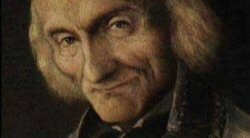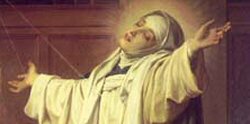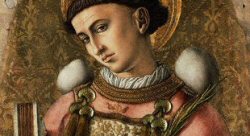 The Post below was written and compiled by Fr. Phillips on his blog AtonementOnline.
The Post below was written and compiled by Fr. Phillips on his blog AtonementOnline.
 Bl. Miguel Pro in the final seconds before his martyrdom.
Bl. Miguel Pro in the final seconds before his martyrdom.
Because the firing squad failed to kill him, Bl. Miguel Pro received a final point blank shot to end his earthly life.
Anyway, my profound respect for Blessed Miguel has made me, over the years, look at the lives of others who were martyred during that horrible period in Mexico’s history. The following comments about them come from the website, Catholic.net:
+ Fathers Cristobal Magallanes Jara and Agustin Caloca were martyred together on May 25, 1927 at Colotitlan, Jalisco. Father Magallanes was accused of promoting the Cristero revolt, although he had preached and written against armed rebellion. While he was in jail, he told Father Caloca, “Cheer up, God loves the martyrs . . . one moment and we are in Heaven.” Father Caloca, responded, “We have lived for God and in him we die.” Before he was shot, Father Magallanes distributed his few possessions among his executioners and gave them absolution, saying: “I am innocent and I die innocent. I forgive with all my heart those responsible for my death, and I ask God that the shedding of my blood serves toward the peace of our divided Mexico.”
+ Father David Galvan, a seminary teacher, was arrested while on his way to aid the victims of a confrontation in Guadalajara on January 30, 1915. Warned that he might be killed, he replied, “What greater glory is there than to die saving a soul?” He was executed by firing squad.
+ Father Luis Batiz, and the Catholic laymen David Roldan, Salvador Lara, and Manuel Moralez were killed August 15, 1926 at Chalchihuites, Zacatecas. The three laymen were officers of the Liga Defensora de la Libertad Religiosa. Father Batiz was accused of plotting an uprising. The four were offered their freedom if they recognized the legitimacy of President Calles’s anti-religious laws. All of them refused. Father Batiz asked the soldiers to free Morales, because he had children, but Morales told them, “I am dying for God, and God will care for my children.” He raised his hat as the soldiers fired. The others died crying out “ Viva Cristo Rey! Viva Santa Maria de Guadalupe!”
+ On January 17, 1927, Father Jenaro Sanchez, a pastor in Tecolotlan, Jalisco, was arrested and hanged from a mesquite tree. When the soldiers put the rope around his neck, he said, “My countrymen, you are going to hang me, but I pardon you, and my Father God also pardons you, and long live Christ the King!”
+ As a young priest Father Mateo Correa gave First Communion to Miguel Pro. In 1927, frail and elderly, he was taking the viaticum to a sick parishioner near Valparaiso when he was caught and accused of being in league with the Cristeros. Taken to Durango, he heard the confessions of some Cristeros awaiting execution. When the commander demanded to know what they had said, the brave confessor refused to answer, and he was shot.
+ On March 26, 1927, Father Julio Alvarez, pastor of Mechoacanejo, Jalisco, was arrested, tied to the saddle of a horse, and led away to Leon. On hearing his sentence, he said, “I know that you have to kill me because you are ordered to do so, but I am going to die innocent because I have done nothing wrong. My crime is to be a minister of God. I pardon you.” He crossed his arms and the soldiers fired, then threw his body onto a trash heap near the church.
+ While in prison in Cuernavaca, Father David Uribe wrote, “I declare that I am innocent of the things of which I am accused. . . . I pardon all my enemies and I beg pardon from any that I have offended.” On April 12th, 1927, he was shot in the back of the head near San Jose Vidal, Morelia.
+ On April 11, 1927, the pastor of Totolan, Jalisco, Father Sabas Reyes was arrested, beaten, and tortured, but he suffered with heroic patience. His hands and feet were burned, he was starved, left in the sun, and given nothing to drink. He was beaten until a number of his bones were broken and his skull was fractured. On April 13, he was taken to the cemetery and shot. Three or four times the rifles spoke; each time, Father Reyes raised his head and cried out “Viva Cristo Rey.”
+ Father Roman Adame, the parish priest of Nochistlan, Zacatecas, was denounced and arrested on April 18, 1927. He was forced to walk barefoot from Mexticacan to Yahualica, until a soldier offered his horse when he realized the elderly priest could not walk another step. For three days, Father Adame was kept tied to the columns in front of his jail, given neither food nor water. Although a ransom was paid, he was taken to the cemetery on April 21 and shot. One of the soldiers from the firing squad refused to take part in the execution; in punishment he himself was shot.
+ Father Jose Isabel Flores of Zapotlanejo, Jalisco, was denounced, arrested, and starved for three days. On June 21, 1927, he was taken to the cemetery and tortured by being hanged from a tree limb, then raised up and down three or four times. Finally he told his tormentors: “This is not the way you are going to kill me, my children. . . . But just let me say, if you received the sacraments from me, don’t cripple the hands that served you.”
One of soldiers present, who had been baptized by Father Flores, then refused to take part in the execution; once again, the soldier himself was immediately shot. When the guns of the remaining soldiers did not fire properly, the commanding office slit the throat of Father Flores with his sword.
+ Father Jose Maria Robles was pastor of Tecolotlan, Guadalajara. He founded the congregation of sisters known as the Hermanas del Corazon de Jesus Sacramentado. In response to suggestions that he should leave his parish to avoid persecution, he said, “The shepherd can never abandon his sheep.” He was arrested and, in defiance of a legal stay of his execution, he was led on horseback to an oak tree where he prayed briefly, blessed the members of his parish, then pardoned and blessed his murderers. He kissed the rope, put it around his neck, and was hanged on June 26, 1927.
+ Father Miguel de la Mora, pastor at Colima, was on a trip with friends and stopped for breakfast when a woman asked him to officiate at her daughter’s wedding. Some government officials overheard the conversation, and arrested the group, taking them back to Colima. Advised of his sentence, Father Miguel calmly recited his rosary. He was shot August 7, 1927.
+ In October 1927, Father Rodrigo Aguilar, a priest in Union de Tula, Jalisco was betrayed and captured by government soldiers. He was taken to the main square of Ejutla where he blessed and forgave his executioners. One of the soldiers arrogantly asked, “Who lives?” telling him he would be spared if he would answer: “Long live the supreme government.” Instead, in a firm voice, the priest responded, “Christ the King and Our Lady of Guadalupe.” Furiously the soldier pulled on the rope to suspend the priest in mid-air. Then he lowered him and again asked, “Who lives?” Father Aguilar gave the same answer. When the same question and answer were repeated a third time, the soldier left the priest to hang until death.
+ During the height of the persecution, a bishop in the state of Guerrero could not find a priest willing to go to the parish of Atenango del Rio, because city officials had threatened to kill any priest who dared to go there. When he heard of that problem, Father Margarito Flores—a seminary professor and vicar of Chilapa, Guerrero—volunteered at once. On the way, he was caught and forced to walk to Tuliman in the blazing sun, half naked and barefoot. Serenely, Father Flores shared his last meal with his captors, then was taken behind the church where he blessed the soldiers and prayed as he was led forward. He was shot on November 12, 1924.
+ When he was advised to leave his parish, Father Pedro Esqueda of San Juan de los Lagos, Jalisco, responded “God put me here; He knows where I am.” November 18, 1927, he was captured by government troops at a private home. He was brutally tortured for four days, but suffered in silence. On November 22, he was led to a mesquite tree and ordered to climb it. Although he attempted to obey, he could not because his arm was broken. He was tortured again, then shot.
+ On February 5, 1928, the parish priest of Valtierilla, Michoican, Father Jesus Mendez had just celebrated Mass secretly when he heard fighting outside the house where he was staying. He left by a back window, taking the chalice under a tilma, but was stopped by a soldier who thought he was carrying arms. He quickly admitted he was priest. Taking his prisoner to the town plaza, the commanding officer attempted three times to kill him. On the first attempt the officer’s pistol misfired. So he ordered his soldiers to shoot the priest, but not a single shot hit Father Mendez (possibly because no one wanted to kill him). Finally, the soldiers removed the priest’s medals and cross, and on a third attempt they succeeded at least in wounding him; one of the soldiers then gave him the coup de grace. His body was thrown on the railroad tracks, but the wives of the town officials rescued and buried it.
+ Father Toribio Romo was assigned at Tequila, Jalisco where he lived in an abandoned factory. He prayed for courage, telling his sister, “I am cowardly, so if one day God wants me to be killed, I hope he will give me a rapid death, with only the time necessary to pray for my enemies.” In the early morning of February 25, 1928, government troops forced the local mailman to show them where the secret Masses were celebrated. They surprised Father Romo and shot him in his bed, stripped his body of clothing, and threw the naked corpse in front of the city hall.
+ Father Justino Orona, parish priest at Cuquio, Jalisco, wrote to a friend, “Those of us who walk the road of sorrows with fidelity can leave for heaven with a feeling of security.” On June 29, 1928, at a local ranch, he and his young vicar, Father Atiliano Cruz, recited the rosary and planned their hidden ministry. He asked Father Cruz if he was afraid of the soldiers, and the younger priest replied that he would greet them with the words, “Viva Cristo Rey.” At dawn on July 1, soldiers broke into the house where the two priests were sleeping. Father Cruz greeted them as he had promised, in a strong clear voice. Father Orona was killed immediately; Father Cruz was mortally wounded. Their bodies were thrown in the town plaza.
+ Father Tranquilino Ubiarco was arrested on October 5, 1928, while officiating at a wedding in a private home. As he was led to his execution, he asked who was commissioned to kill him. When all the soldiers remained silent, he said, “All of this is God’s will; the man who is made to kill me is not responsible.” One of the soldiers then confessed that he was the one who had been chosen, but he now felt that he could not carry out the assignment. Calmly, Father Ubiarco blessed all the soldiers. They hanged him from the branch of a eucalyptus tree at the entrance of town. Once again, the soldier in charge of the execution refused to carry out the order, so he was shot.
+ Because of the political unrest in Mexico, Father Pedro de Jesus Maldonado was ordained in El Paso, Texas. Returning home, he became pastor of Santa Isabel, Chihuahua. In the early 1930s, he was sent back to safety in Texas, but he begged to be allowed to return. A group of armed and drunken men arrested him at his house and made him walk barefoot to Santa Isabel. He recited his rosary along the way. He was beaten and hit on the head so hard that his left eye popped out. He had prayed for the grace of receiving final Communion. He had a consecrated host with him in a pyx, and when his murderers found it, one of them forced him to eat it saying, “Eat this, this is your last Communion!” He was then beaten until he was unconscious, then taken to the civil hospital where he died on February 11, 1937.
What men these were! I’m sure not one of them, in his youth, imagined he would have his life end as it did. But God gave them His grace for courage -- and each one used it for God’s glory, and for the Gospel.
























2 comments:
thank you...
H
Again, thank you.
Post a Comment